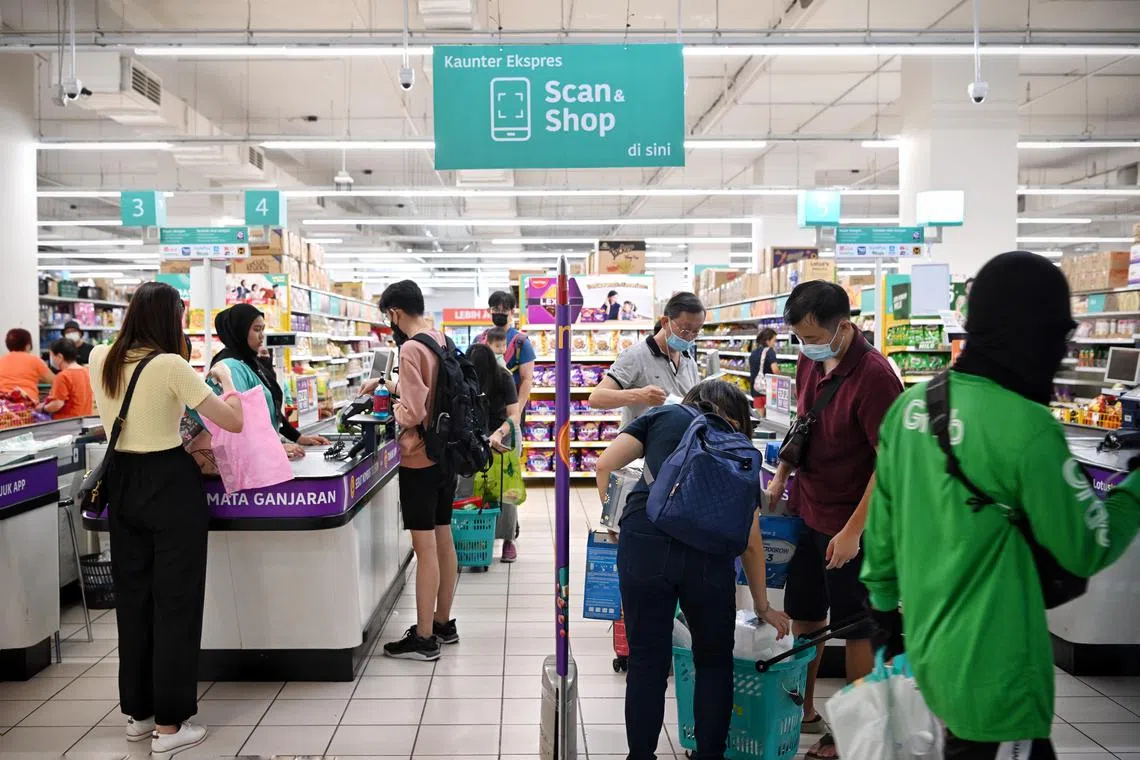Singapore and Malaysia users of Nets, DuitNow can now pay with new QR code link
Sign up now: Get ST's newsletters delivered to your inbox

Customers of participating financial institutions can now pay for products and services by scanning physical Nets and DuitNow QR codes.
ST PHOTO: KUA CHEE SIONG
Follow topic:
SINGAPORE – Singapore and Malaysia residents now have a more convenient way to make payments when they travel across the Causeway, following the launch of cross-border QR code payment connectivity on Friday.
The Monetary Authority of Singapore (MAS) and Bank Negara Malaysia (BNM) jointly announced that customers of participating financial institutions will be able to pay for products and services at merchants by scanning physical Nets or DuitNow QR codes.
Cross-border online transactions for e-commerce will also be supported.
As at Friday, the participating institutions in Singapore are DBS Bank, OCBC Bank and UOB.
In Malaysia, the participating establishments are AmBank Malaysia, e-wallet operator Boost, CIMB Bank, Hong Leong Bank, Maybank, Public Bank, Razer Merchant Services, TNG Digital, and UOB Malaysia.
An MAS-BNM statement said: “With pre-pandemic annual traffic between the two countries averaging 12 million visitors, the payment linkage will provide merchants and consumers with a more seamless and efficient means to make and receive payments.”
Mr Joses Khoo, a 30-year-old logistics business owner in Malaysia, said business-to-consumer businesses, especially retail merchants such as cafes and clothing shops, will benefit.
“Their customers do not have to exchange cash for retail purchases at cafes and clothing shops, for example. Just use QR payment,” he added.
Mr Khoo said there has been good adoption of DuitNow QR across the market, with “more than 80 per cent adoption in Klang Valley, Johor, and other major cities in Malaysia”.
DuitNow QR is a QR standard that allows Malaysians to make payments and receive funds from any participating bank and e-wallet via a QR code.
“Coffee shops, goreng pisang seller, small grocery shops and night markets on the street, most have QR,” he said, adding that he hopes the transaction fees will not be significant and that the exchange rate will be good.
Another Malaysian business owner, Mr Kuhan Pathy from Pepper Labs Social Enterprise, was less upbeat.
He said the smaller enterprises generally prefer to use Touch ’n Go because the cards are also used for public transportation and to pay road tolls. Mid- to larger-sized businesses opt for both DuitNow and Touch ’n Go, he added.
His own food and beverage social enterprise, The Masala Wheels Cafe, uses both Touch ’n Go and DuitNow “to provide multiple options for diners”.
Consumers like Singaporean Kel Lee, 41, who travel to Malaysia for the food and to shop, are happy because they now have a cashless payment option.
Ms Lee goes to Johor Bahru at least once a month.
“Sometimes you eat at local coffee shops or small eateries, these places accept cash. I always have to remember to change cash at the money changer. Without cash, it is very inconvenient,” Ms Lee said, adding that she will then be forced to buy from a shopping mall or eat at bigger restaurants.
Ms Jacquelyn Tan, head of group personal financial services at participating bank UOB, said DuitNow QR will “open a new frontier in the cross-border spending landscape in Malaysia”.
DuitNow QR, she said, targets lower-value transactions that were previously made in cash. This will complement credit- and debit-card payments for higher-value transactions, where customers can earn rewards while they spend, Ms Tan added.
The average payment made to the top 20 UOB Malaysia DuitNow QR merchants over the December 2022 to February 2023 period was RM34 (S$10.30).
Almost 65 per cent of these DuitNow QR payments took place at eateries, minimarts and dry markets, Ms Tan said.
In 2022, DuitNow QR transactions within Malaysia processed by UOB Malaysia grew by more than eight times from 2021, she added. “Together with other factors, such as the number of Singapore travellers to Malaysia as well as the expected size of the market, we expect cross-border DuitNow QR spending to quadruple from this year’s level in the next five years.”
Mr Gary Wong, head of digital payments and ecosystems at another participating bank OCBC, said DuitNow QR will reduce the need for cash and facilitate safe and easy cross-border payments.
“Now that travel is back in full swing, we also expect DuitNow QR to strengthen OCBC’s overall travel proposition,” he added.
OCBC customers’ overall spend in Malaysia rose in 2022 – the number of transactions and amount spent increased by more than 75 per cent from 2021.
A Maybank Singapore spokesman said Maybank Malaysia customers will now be able to scan Nets QR codes in Singapore with their mobile banking app and enjoy a “seamless banking experience” in Singapore. Likewise, the bank’s Singapore customers can participate in the cross-border QR payment, leveraging Maybank Malaysia’s extensive merchant base.
MAS and BNM said that they planned to roll out cross-border person-to-person fund transfers by the end of 2023, allowing people to transfer money to each other using a phone number via PayNow and DuitNow.
MAS managing director Ravi Menon said: “This QR code linkage between Singapore and Malaysia is an important milestone in Asean’s journey towards seamless regional payments connectivity.”
He added that such cross-border links will boost commerce beyond the Republic’s borders and also allow smaller businesses to access a wider pool of customers.

